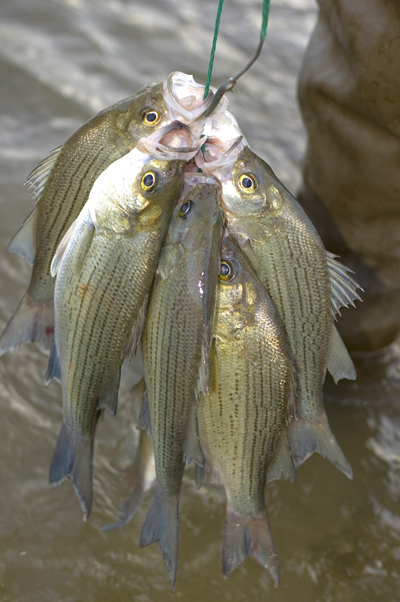I pulled my biggest catch ever out of the Sabine River one sunny March afternoon. It weighed well over a hundred pounds. Combined with a two-day limit of white bass, it was arguably the best fishing trip imaginable.
We stayed at River Ridge near Carthage and fished the Sabine above Toledo Bend Reservoir. Houston Chronicle outdoor writer, Shannon Tompkins, had told me about the Sabine’s three-pound whites. Fishing there with him convinced me he was right. We didn’t catch any threes, but we caught a lot that came quite close.
 I fish for whites every spring, and several times after they return to the lakes. Primarily an open water fish, they vacate the big lakes each spring to seek running water for spawning in the rivers and creeks feeding the reservoirs. They’re probably staging right now in deep holes in the upper ends of the lakes, preparing to head upstream.
I fish for whites every spring, and several times after they return to the lakes. Primarily an open water fish, they vacate the big lakes each spring to seek running water for spawning in the rivers and creeks feeding the reservoirs. They’re probably staging right now in deep holes in the upper ends of the lakes, preparing to head upstream.
It happens all over the state. Lake Ray Roberts, north of Denton, is a North Texas hotspot, where the whites fin their way up the Elm Fork of the Trinity.
Lake Whitney, on the Brazos, west of Waco, sends hundreds of thousands up the river. Bedias Creek provides running water above Lake Livingston, northeast of Huntsville, and hosts a favorite memory of a foggy morning, and another limit of whites.
West of Austin, the Pedernales River is a classic white bass Mecca for the fish moving up from Lake Travis. The Nueces, above Lake Corpus Christi, is still another. And South Texans also limit on the three rivers at Three Rivers.
The list goes on. So many choices — but so little time. On sunny days in late January and early February, as the water temperature edges toward 60 degrees, reports begin coming in of good catches. It’s primarily a February-March thing, but occasionally extends into April. Get ready for it.
The menu of baits is almost as long as the list of streams. Their favorite food in the lakes is shad; in the streams, it’s minnows. Live minnows consequently work well.
If you don’t want to lug a minnow bucket, try anything that looks like a shad or minnow. Small white or chartreuse jigs – 1/16th or 1/32nd ounce – with a Marabou feather or a plastic skirt, will fill a stringer.
One eighth ounces jigs are more effective in stained water. Crème’s Lit’l Fishies get gobbled up, too. In deeper water, try a Shad Rap.
Light copolymer fishing line – 4-6 pound test – is ideal. Nothing more than 8-pound test. Then what?
Filet each fish, discarding any red meat, roll fish in Bisquik, and gently fry in olive oil. Yumm! Share with only your best friends!
Oh, my hundred-pound catch in the Sabine? Two game wardens stopped to chat, and as we watched a rabbit swim the river behind us, we heard a terrific splash. Tompkins had been holding both boats together; then apparently lost his grip.
Wish I had had a bigger stringer … and a picture!
JJ





